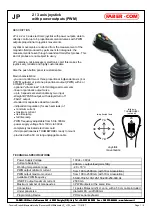
BASIC OPERATION AND FEATURES
SX TRANSISTOR CONTROL
Page 7
April 1999
will be determined by GE and OEM engineers at the time of
vehicle development. This setting must not be changed by
field personnel without the permission of the OEM.
Section 2.1.4.b Speed Limits
This feature provides a means to control speed by re-
scaling the maximum number of tachometer pulses to a set
value at the maximum throttle to be regulated. These
speeds are set by Functions 11 and 12. These speed limits
are activated by a normally open switch to positive 12 volts.
Section 2.1.5 Ramp Start
This feature provides maximum control torque to restart a
vehicle on an incline. The memory for this function is the
directional switch. When stopping on an incline, the
directional switch must be left in its original or neutral
position to allow the control to initiate full power when
restarted. The accelerator potentiometer input will
modulate ramp start current.
Section 2.1.6 On-Board Coil Drivers & Internal Coil
Suppression
Coil drivers for the LINE and SP or BYPASS contactors
are on-board the control card. These contactors must have
coils rated for the vehicle battery volts.
Section 2.2 System Protective Override
Section 2.2.1 Static Return to Off (SRO)
This inherent feature of the control is designed to require
the driver to return the directional lever to the neutral
position anytime he removes his foot from the foot switch.
Section 2.2.2 Accelerator Volts Hold Off
This feature checks the voltage level at the accelerator
input whenever the key switch or seat switch is activated.
If, at start up, the voltage is less than 3.0 volts, the control
will not operate. This feature assures that the control is
calling for low speed operation at start up.
Section 2.2.3 Pulse Monitor Trip (PMT)
The PMT design contains three features which shut down,
or lock out, control operation if a fault conditions occurs
that would cause a disruption of normal vehicle operation:
•
=
Look ahead
•
=
Look again
•
=
Automatic look again and reset
The PMT circuit will not allow the control to start under the
following conditions:
•
=
The control monitors both armature and field FET's at
start-up and during running.
•
=
The control will not allow the line contactor to close at
start-up, or will drop it out during running, if either the
armature or field FET's are defective, so as to cause
uncontrolled truck movement.
Section 2.2.4 Thermal Protector (TP)
This temperature sensitive device is internal to the power
transistor (Q1) module. If the transistor's temperature
begins to exceed the design limits, the thermal protector
will lower the maximum current limit, and maintain the
transistors within their temperature limits. As the control
cools, the thermal protector will automatically reset,
returning the control to full power.
Section 2.2.5 Low Voltage
Batteries under load, particularly if undersized or more
than 80 percent discharged, will produce low voltages at
the control terminals. The SX control is designed for use
down to 50 percent of a nominal battery voltage of 36-84
volts, and 75 percent of a nominal battery voltage of 24
volts. Lower battery voltage may cause the control to
operate improperly, however, the resulting PMT should
open the Line contactor, in the event of a failure.
Section 2.3 Diagnostics
Section 2.3.1 Systems Diagnostics
The control detects the system's present operating status
and can be displayed to either the Dash Display or the
Handset. There are currently over 70 status codes that are
available with SX systems using Traction and Pump
controls and Truck Management Module (TMM). Along
with the status code display from the TMM, the SX control
is capable of reducing the current to the motor, alerting the
operator of a critical fault condition.
Section 2.3.2 Status Codes
Section 2.3.2a Standard Status Codes
The SX traction control has over 30 Status Codes that
assist the service technician and operator in trouble
shooting the vehicle. If mis-operation of the vehicle occurs,
a status code will be displayed on the Dash Display for
vehicles so equipped, or be available by plugging the
Handset into the “y” plug of the logic card.
With the status code number, follow the procedures
outlined in DIAGNOSTIC STATUS CODES to determine the
problem and a solution.








































